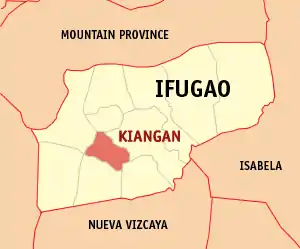| Tuwali | |
|---|---|
| Native to | Philippines |
| Region | Kiangan, Ifugao |
Native speakers | 30,000 (2000)[1] |
Austronesian
| |
| Latin | |
| Official status | |
Official language in | Regional language in the Philippines |
| Language codes | |
| ISO 639-3 | ifk |
| Glottolog | tuwa1243 |
 Ifugao, showing the location of Kiangan | |
Tuwali language is a native language indigenous to Ifugao. It is mainly spoken in the whole province. Its different varieties distinguish the municipality.
Kiangan is the oldest town in the province. It derives its name from Kiangan, an ancient village near the bank of the Ibulao River across the Lagawe valley.
References
- ↑ Tuwali at Ethnologue (18th ed., 2015) (subscription required)
Further reading
- Hohulin, Richard M.; Hohulin, E. Lou (2014). Tuwali Ifugao Dictionary and Grammar Sketch. Manila: Linguistic Society of the Philippines. ISBN 978-971-780-031-8.
External links
| Official languages | |
|---|---|
| Regional languages | |
| Indigenous languages (by region) | |
| Immigrant languages | |
| Sign languages | |
| Historical languages | |
| Batanic (Bashiic) | |||||||||||||||||||||||||
|---|---|---|---|---|---|---|---|---|---|---|---|---|---|---|---|---|---|---|---|---|---|---|---|---|---|
| Northern Luzon |
| ||||||||||||||||||||||||
| Central Luzon |
| ||||||||||||||||||||||||
| Northern Mindoro | |||||||||||||||||||||||||
| Greater Central Philippine |
| ||||||||||||||||||||||||
| Kalamian | |||||||||||||||||||||||||
| Bilic | |||||||||||||||||||||||||
| Sangiric | |||||||||||||||||||||||||
| Minahasan | |||||||||||||||||||||||||
| Other branches |
| ||||||||||||||||||||||||
| Reconstructed | |||||||||||||||||||||||||
| |||||||||||||||||||||||||
This article is issued from Wikipedia. The text is licensed under Creative Commons - Attribution - Sharealike. Additional terms may apply for the media files.